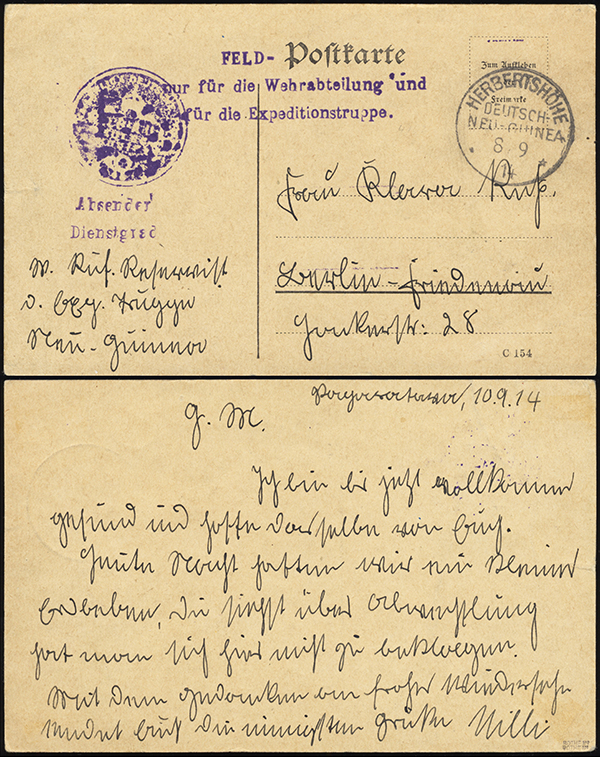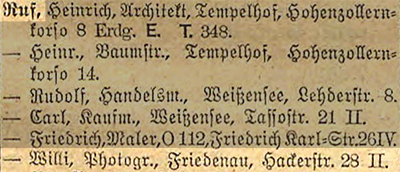Post by PostmasterGS on May 9, 2022 9:44:33 GMT -5
At the outbreak of World War I on 28 July 1914, Germany had no tropops in its colony of Deutsch-Neuguinea (German New Guinea), or DNG. The only armed force was a police force of approximately 450 men under the leadership of 2 officers and 16 NCOs, all armed with old, obsolete rifles.
When word reached the colony on 6 August 1914 that war had been declared, the decision was made to withdraw the police force from the two large settlements in Rabaul and Herbertshöhe and declare them open cities to avoid unnecessary damage to them. The police were sent to guard the most important item in the colony, the radio station in Bitapaka which was a key communications link between Germany and Admiral von Spee’s East Asian Cruiser Squadron, which was then maneuvering to avoid then surprise the Royal Navy. To augment the police force, a Defense Corps consisting of 50 men was created, with membership consisting of men of the German army and navy who were in the area on furlough and a few local volunteers.
To facilitate postal service to these forces, a feldpost (field post) service was organized, with service limited to postcards and letters weighing no more than 50 grams. The service had no postal installation of its own. Rather, approximately 1,000 postcards were handstamped with a rubber stamp “Feld-“ [Postkarte] and the instructions, “nur für die Wehrabteilung und für die Expeditionstruppe” (only for the Defense Corps and the Expeditionary Force). The postcards were authenticated by a rubber stamp of the official seal of the Rabaul post office.
Most of these feldpost cards were sent to the POs in Rabaul and Herbertshöhe for distribution to the forces, with a few sent to Bitapaka and Toma. On 12 August 1914, Australian forces destroyed portions of the post offices in Rabaul and Herbertshöhe, but did not occupy the towns. The post offices remained open until mid-September 1914, but no further “official” feldpost cards could be created during the intervening weeks, as the Rabaul official seal had been destroyed. Any feldpost cards after approximately 12 September 1914 were created simply by handwriting “feldpost” on a postcard.
However, the normal cancellers were not destroyed on 12 August 1914, and the then-existing “official” feldpost cards could still be used to send messages home until the closing of the German post offices in mid-September 1914. These feldpost cards are among the rarest of German Colonial Feldpost items in used condition, as few were used and even fewer survive.

This card was cancelled in Herbertshöhe on 8 September 1914, but was dated by the sender on 10 September 1914. This discrepancy is likely a result of pre-cancellation by the Herbertshöhe post office due to the impending closure of the PO — it was captured by Australian forces on 11 September 1914. The date on this cancellation, 8 September 1914, is the last day of the range in which Feldpost cancels are known, 10 August - 8 September 1914.
It's uncertain whether this card ever made it to Germany (at least at that time). The last known mail shipment from DNG prior to its capture was on either 8 or 10 September 1914, and this card lacks censor marks that should have been applied. This isn’t a guarantee, as censor marks weren’t universally applied in the last shipments out, but there’s no way to know at this point whether censorship was skipped in the last-minute shuffle or it never made it into the mail stream due to the fall of the POs. Regardless, it is a certified legitimate usage of the card, and is one of only a handful of known used copies.
The card was sent from Willi Ruf, a Reservist with the Expeditionary Force, to Klara Ruf in Berlin-Friedenau. I haven't found any information yet on how Willi came to be in DNG, but I found this entry in a 1915 Berlin address book indicating that a Willi Ruf lived at Hackerstraße 28, Berlin-Friedenau — the same address as the recipient — and he was a photographer.

The card reads as follows:
When word reached the colony on 6 August 1914 that war had been declared, the decision was made to withdraw the police force from the two large settlements in Rabaul and Herbertshöhe and declare them open cities to avoid unnecessary damage to them. The police were sent to guard the most important item in the colony, the radio station in Bitapaka which was a key communications link between Germany and Admiral von Spee’s East Asian Cruiser Squadron, which was then maneuvering to avoid then surprise the Royal Navy. To augment the police force, a Defense Corps consisting of 50 men was created, with membership consisting of men of the German army and navy who were in the area on furlough and a few local volunteers.
To facilitate postal service to these forces, a feldpost (field post) service was organized, with service limited to postcards and letters weighing no more than 50 grams. The service had no postal installation of its own. Rather, approximately 1,000 postcards were handstamped with a rubber stamp “Feld-“ [Postkarte] and the instructions, “nur für die Wehrabteilung und für die Expeditionstruppe” (only for the Defense Corps and the Expeditionary Force). The postcards were authenticated by a rubber stamp of the official seal of the Rabaul post office.
Most of these feldpost cards were sent to the POs in Rabaul and Herbertshöhe for distribution to the forces, with a few sent to Bitapaka and Toma. On 12 August 1914, Australian forces destroyed portions of the post offices in Rabaul and Herbertshöhe, but did not occupy the towns. The post offices remained open until mid-September 1914, but no further “official” feldpost cards could be created during the intervening weeks, as the Rabaul official seal had been destroyed. Any feldpost cards after approximately 12 September 1914 were created simply by handwriting “feldpost” on a postcard.
However, the normal cancellers were not destroyed on 12 August 1914, and the then-existing “official” feldpost cards could still be used to send messages home until the closing of the German post offices in mid-September 1914. These feldpost cards are among the rarest of German Colonial Feldpost items in used condition, as few were used and even fewer survive.

This card was cancelled in Herbertshöhe on 8 September 1914, but was dated by the sender on 10 September 1914. This discrepancy is likely a result of pre-cancellation by the Herbertshöhe post office due to the impending closure of the PO — it was captured by Australian forces on 11 September 1914. The date on this cancellation, 8 September 1914, is the last day of the range in which Feldpost cancels are known, 10 August - 8 September 1914.
It's uncertain whether this card ever made it to Germany (at least at that time). The last known mail shipment from DNG prior to its capture was on either 8 or 10 September 1914, and this card lacks censor marks that should have been applied. This isn’t a guarantee, as censor marks weren’t universally applied in the last shipments out, but there’s no way to know at this point whether censorship was skipped in the last-minute shuffle or it never made it into the mail stream due to the fall of the POs. Regardless, it is a certified legitimate usage of the card, and is one of only a handful of known used copies.
The card was sent from Willi Ruf, a Reservist with the Expeditionary Force, to Klara Ruf in Berlin-Friedenau. I haven't found any information yet on how Willi came to be in DNG, but I found this entry in a 1915 Berlin address book indicating that a Willi Ruf lived at Hackerstraße 28, Berlin-Friedenau — the same address as the recipient — and he was a photographer.

The card reads as follows:
I have been perfectly healthy so far and I hope you are too. Tonight, we had a small earthquake, you don't have to complain about variety here. With thoughts of a happy reunion I am sending you my warmest regards.
Willi
Willi





